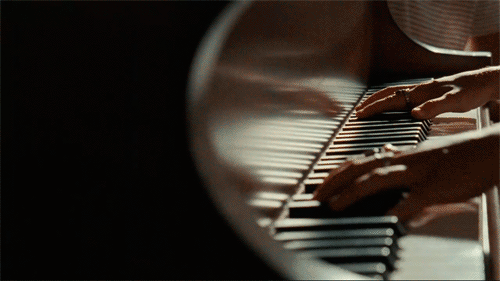Something inside needs to be said but
cannot be pressed with pen into paper;
dissonant chords and jarring staccatos
and lyricism of tears once they break –
these I can not lay flat and linear
Something inside won’t be coaxed into form –
by silvery layers of cross-hatched lines
nor with wire, water, blunt knife, and two fists –
from the muddled slab to something ornate.
It won’t be spoken in twists of the tongue,
refuses to glide upon open air
for it is a snarled tangle, lodged too deep –
too deep in my lungs to be loosed without
catching on airways and sealing my lungs
starting to strangle me from deep within.
These knots too tightly bound by fists yanking
the wrong strings in the wrong way and causing
the tangles to tighten, becoming dense
masses of interwoven filaments –
interlocking, indistinguishable,
inhabiting my body in knotted
muscles and tension encasing my spine.
Strings.
I find release in the ways my fingers
beat against ebony and ivory,
as if wordless emotion, needs unnamed
become tendons driving my fingertips,
dictating the piano and forte.
With instinct, they find the notes they needed,
ones that resound with thunderous timbre,
and always linger on A minor as
it reminds me of tender, spring rainstorms
Finally – like a symphonic cloudburst –
trickling down veins in my forearms and
seeping out from under my fingernails,
that old unsaid Something comes screaming out
and, though the release is short-lived like the
sun’s sudden gold and prismatic raindrops,
the peace of music lingers – whispering,
the slipknots sunk in my windpipe dissolve
as I wordlessly speak – loud as lighting.
What the heck you just read:
(topic)
I was inspired to write this on a day when I felt the inexplicable need to express something, though I wasn’t sure what the thing was. I tried writing, waiting for the feelings in me to spill onto the page. They didn’t. So I pulled out my sketchbook, which is usually the solution in such a situation, and I waited for a form to take hold of my hands, sketching itself across the paper. It didn’t. And then I tried music; I played piano for about two hours and I just couldn’t stop because it was exactly what I needed. Whatever I was feeling was wordless, could not be expressed with anything but music – which is something I can’t fully explain.
I find that the emotions I experience take different forms; some are logical and can be expressed linguistically, others are best expressed visually, and still others can only be conveyed with sound. When I feel the need to creatively express my emotions, I often have to play a bit of a guessing game, experimenting with the best method of expression.
(stylistic choices)
The free-verse poem itself is written in a ten-syllable quantitative meter. This means that each line (with two exceptions, which I will explain later) is written with ten syllables. It is quantitative because I did not focus on the stress of the words, just the syllable count. The only lines that do not follow this pattern are the first and twenty-third, which mark the start of the first and second sections of the poem, respectively. The first line only has nine syllables, which starts off the first section of the poem with a sense of incompleteness. This lines that follow centre around the subject’s futile attempts to find a suitable method of expression, a way to find relief from a gnarly mess of emotions. Because the first line only has nine syllables, the first section finds resolution with the monosyllabic twenty-third line; it is the missing syllable. The word in the twenty-third line, “strings”, plays on the previous stanzas’ description of emotional turmoil as tangled strings, as well as the following stanzas description of the piano – which is partly a string instrument. This syllabic completion coincides with the second section of the poem, which describes finding emotional completion in music.
The last line of the poem makes use of the rhetorical device catachresis: misplacing a word to create a metaphor. The phrase “loud as lightning” parallels the phrase “wordlessly speak”. Obviously lightning is silent; thunder has sound. How can lightning be loud? How can one speak without words? This misplaced word reinforces the paradox of speaking without words – rather, through music. Additionally, it provides a culmination to the rainstorm imagery in the second section of the poem, which represents the subject’s emotional release.


This piece reminds me why I love having the explication to see into your genius.
Genius might be a strong word, but thank you so much Hunni. 😉
Dearest Lauryn,
Thank you so much for putting what I’ve been feeling for the past couple of months into words- despite the irony of that 🙂 . I absolutely love this piece because it is so different from anything I’ve ever read. As someone who is looking to try unique poetic structures, I learnt a lot by reading your piece and I honestly don’y have any suggestions for improvement.
Bravo!
Love,
Liza
Dear Liza,
Thank you so much for your praise! I absolutely love that moment of having feelings validated so I’m glad this piece could be there for you. Thanks for reading 💕
Love,
Lauryn